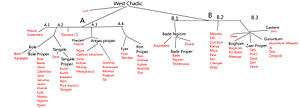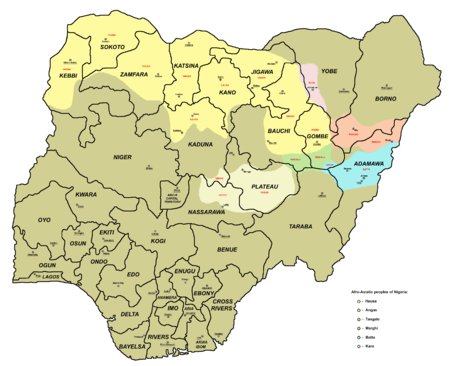Barawa languages
The Barawa languages (also called the B.3 West Chadic or South Bauchi languages) are a branch of West Chadic languages that are spoken in Bauchi State, northern Nigeria.
| Barawa | |
|---|---|
| South Bauchi; B.3 West Chadic | |
| Geographic distribution | Toro, Dass, Tafawa Balewa, Bauchi LGAs of Bauchi State, Nigeria |
| Linguistic classification | Afro-Asiatic
|
| Glottolog | west2800[1] |
 West Chadic per Newman (1977) | |

Main Chadic-speaking peoples in Nigeria
An extensive lexical survey of the Barawa (South Bauchi) languages had been carried out by Kiyoshi Shimizu (1978).[2]
Names and locations
Below is a comprehensive list of Barawa language names, populations, and locations from Blench (2019).[4]
| Language | Branch | Cluster | Dialects | Alternate spellings | Own name for language | Endonym(s) | Other names (location-based) | Other names for language | Exonym(s) | Speakers | Location(s) | Notes |
|---|---|---|---|---|---|---|---|---|---|---|---|---|
| Aja (extinct) | Zaar | North Bauchi | Ajanci | Extinct: formerly spoken at Kworko, Bauchi State | no data | |||||||
| Das cluster | Zaar | Das | Ɓarawa | 8,830 (LA 1971) | Bauchi State, Toro and Dass LGAs | |||||||
| Lukshi | Zaar | Das | Dәkshi | 1,130 (LA 1971) | ||||||||
| Durr–Baraza | Zaar | Das | Bandas | 4,700 (LA 1971); 30-40,000 (Caron 2005) | Bauchi State, Das LGA, Durr and Baraza villages | |||||||
| Zumbul | Zaar | Das | Boodlә | Zumbulawa, Dumbulawa | See Wandi | Bauchi State, Das LGA, Zumbul town | ||||||
| Wandi | Zaar | Das | Wangday | 700 (including Zumbul) (LA 1971) | Bauchi State, Das LGA, Wandi town | |||||||
| Dot | Zaar | Das | Dwat | Zoɗi | shérә́m zoɗi | Dott | 2,300 (LA 1971); a single large village. 37,582 (local census 2003). 7 wards (out of 11) speak Zoɗi | South of Bauchi on the Dass road | ||||
| Geji cluster | Zaar | Geji | Kayauri, Kaiyorawa | Ɓarawa | Bauchi State, Toro LGA | |||||||
| Mәgang | Zaar | Geji | Bolu, Buli | Mәg̣ àŋ | 1,250 (LA 1971), 'a few hundred' (Caron 2005) | |||||||
| Pyaalu | Zaar | Geji | Pelu, Belu | Pyààlù | ||||||||
| Geji | Zaar | Geji | Gyaazә | Bagba | Gezawa, Gaejawa | 650 (LA 1971), 1000 (Caron 2005). 20 villages (2007) | Toro, Bauchi LGAs, Bauchi State | |||||
| Buu | Zaar | Geji | Zaranda | Bùù | 750 (LA 1971), 'a few hundred' (Caron 2002) | |||||||
| Guus | Zaar | Guus | Ɓarawa | Sayanci | 50,000 (1971 Schneeberg); 50,000 (1973 SIL) | Bauchi State, Tafawa Balewa LGA. West of Tafawa Balewa town. | ||||||
| Guus | Zaar | Guus | mur gúús (one person); Gùùs (people) | vìì kә gúús (mouth of Guus) | Sigidi, Sugudi, Sigdi, Segiddi | 775 (1950 HDG). 17 villages (Caron 2002) | ||||||
| Polci cluster | Zaar | Polci | Ɓarawa, Palsawa | 6,150 or more (1971) | Bauchi State, Bauchi and Toro LGAs | |||||||
| Zul | Zaar | Polci | Zul is mutually comprehensible with Mbaram | Bi Zule | Nya Zule pl. Man Zule | Mbarmi, Barma | Zulawa | 2,400 (LA 1971). 15 villages (2007) | Bauchi State, Bauchi and Toro LGAs | |||
| Mbaram | Zaar | Polci | Barang, Mbaram | 250 CAPRO (1995a). One settlement only | Bauchi State, Bauchi LGA | |||||||
| Dir | Zaar | Polci | Diir | 'a few hundred' (Caron 2005) | ||||||||
| Buli | Zaar | Polci | Bәlә | 600 (LA 1971), 4000 (CAPRO 1995a), 'a few hundred' (Caron 2005) | ||||||||
| Langas | Zaar | Polci | Nyamzax | Lundur | 200 (LA 1971), 'a few hundred' (Caron 2005) | |||||||
| Luri | Zaar | Polci | Lúr | 30 (1973 SIL), 2 (Caron 2002) | Bauchi State, Bauchi LGA | |||||||
| Polci | Zaar | Polci | Posә, Polshi, Palci, Pәlci | 2,950 (LA 1971); 70,000 (Caron 2005) | ||||||||
| Zaar | Zaar | Kal, Gambar Leere, Lusa | Zaʼr, Zar | Vìk Zaar, Vigzar | Zaar pl. Zàrsɛ̀ | Sáyánci | Bàsáyè pl. Sáyáːwá, Saya, Seya, Seiyara [Saya terms are now considered derogatory] | 50,000 (1971 Schneeberg); 50,000 (1973 SIL) | Bauchi State, Tafawa Balewa LGA. West of Tafawa Balewa town. | |||
| Zari cluster | Zaar | Zari | Ɓarawa | Bauchi State, Toro and Tafawa Balewa LGAs; Plateau State, Jos LGA | ||||||||
| Zakshi | Zaar | Zari | Zaksә | 2,950 (1950 HDG) | ||||||||
| Boto | Zaar | Zari | Boot | Bibot | 1,000 (1950 HDG) | |||||||
| Zari | Zaar | Zari | Kopti, Kwapm | |||||||||
| Zeem-Caari-Danshe-Dyarim cluster | Zaar | Zeem-Caari-Danshe-Dyarim | Ɓarawa | Bauchi State, Toro LGA | ||||||||
| Zeem (extinct) | Zaar | Zeem-Caari-Danshe-Dyarim | Extinct (Caron 2005) | |||||||||
| Tule (extinct) | Zaar | Zeem-Caari-Danshe-Dyarim | Tulai | Extinct (Caron 2005) | ||||||||
| Danshe | Zaar | Zeem-Caari-Danshe-Dyarim | Extinct (Caron 2005) | |||||||||
| Chaari | Zaar | Zeem-Caari-Danshe-Dyarim | Tulai | a 'few hundred' speakers (Caron 2005) | ||||||||
| Dyarim | Zaar | Zeem-Caari-Danshe-Dyarim | one person Mәn Dyarim, people Dyarim | Ndyarim Tә | Kaiwari | About 2000 ethnic Dyarim with about 100 fluent speakers (Blench 2005 est.) | Their main settlement is about 7 km south of Toro town in Toro LGA (N10˚ 02, E 9˚ 04). | |||||
| Lushi? | Zaar | Zeem-Caari-Danshe-Dyarim | Lukshi | Dokshi | ||||||||
| Jimi | Zaar | 250 (LA 1971); 400 (1973 SIL) | Bauchi State, Darazo LGA | |||||||||
| Kir–Balar cluster | Boghom | Kir–Balar | 360 (LA 1971) (Kir only) | Bauchi State, Bauchi LGA | no data | |||||||
| Kir | Boghom | Kir–Balar | no data | |||||||||
| Balar | Boghom | Kir–Balar | Larbawa | 50 CAPRO (1995a) | no data | |||||||
| Boghom | Boghom | Burom, Burrum, Burma, Borrom, Boghorom, Bogghom, Bohom, Bokiyim | Burumawa | 9,500 (1952 W&B), 50,000 (1973 SIL) | Plateau State, Kanam LGA | |||||||
| Mangas | Boghom | Maás | 180 (LA 1971) | Bauchi State, Bauchi LGA | no data | |||||||
| Guruntum–Mbaaru | Guruntum | By settlements Dookà, Gàr, Gayàr, Kàràkara, Kuukù, and Mbaarù | Gurutum | Gùrduŋ | 10,000 (1988 Jaggar) | Bauchi State, Bauchi and Alkaleri LGAs | ||||||
| Ju | Guruntum | 150 (LA 1971) | Bauchi State, Bauchi LGA | |||||||||
| Tala | Guruntum | Bauchi State, Bauchi LGA, Zungur district | ||||||||||
| Zangwal | Guruntum | Bauchi State, Bauchi LGA | no data |
gollark: 2:1?
gollark: They are not rare.
gollark: Can I probably sell off 2G xenowyrms for an equal amount of BSA hatchlings?
gollark: I am universally always egglocked when interesting stuff happens, as it turns out.
gollark: I saw a copper briefly; this is more interesting than usual.
References
- Hammarström, Harald; Forkel, Robert; Haspelmath, Martin, eds. (2017). "West Chadic B.3". Glottolog 3.0. Jena, Germany: Max Planck Institute for the Science of Human History.
- Shimizu, Kiyoshi. 1978. The Southern Bauchi group of Chadic languages: a survey report. (Africana Marburgensia: Sonderheft, 2.) Marburg/Lahn: Africana Marburgensia. 48pp.
- Blench, Roger. 2006. The Afro-Asiatic Languages: Classification and Reference List (ms)
- Blench, Roger (2019). An Atlas of Nigerian Languages (4th ed.). Cambridge: Kay Williamson Educational Foundation.
External links
This article is issued from Wikipedia. The text is licensed under Creative Commons - Attribution - Sharealike. Additional terms may apply for the media files.